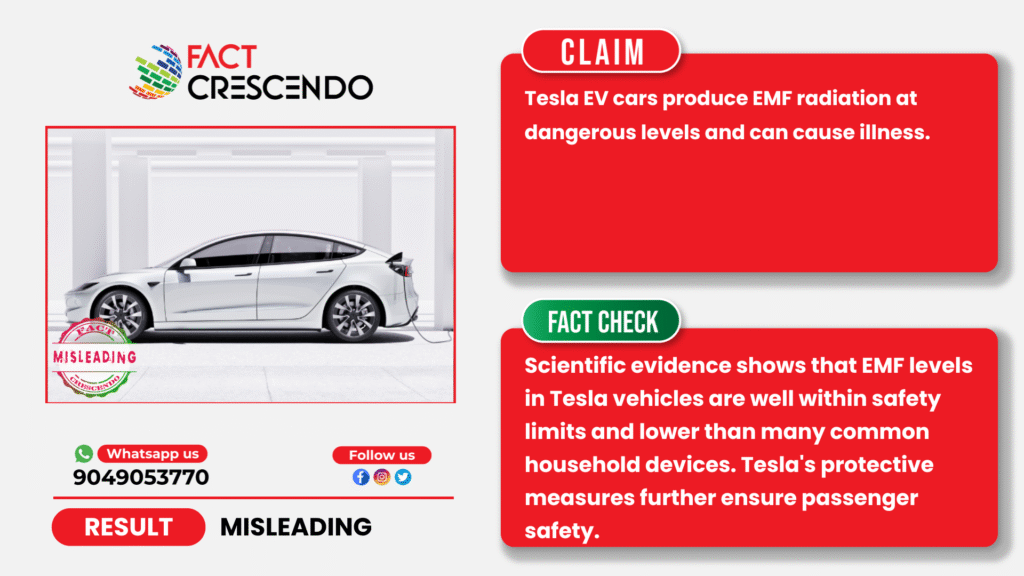
With more electric vehicles (EVs) on the roads, people have started discussing possible health effects on social media. Some are particularly worried about electromagnetic field (EMF) radiation from Tesla cars and whether it might affect drivers and passengers.
Social Media Claim
A Facebook user has posted a video about using a Tesla car and claims it negatively affected his health, along with the caption “EMF Radiation from Tesla EV cars can cause debilitating illness. Toxic batteries run the length of the car and create a metal ‘tomb’ of radiation exposure”.
We also found similar claims about Tesla cars and their EMF emissions, as shown below.
Fact Check
EMF Measurements & Safety Standards
Grace Tao, Tesla China’s VP clarifies that EMF levels in their vehicles range from 0.08 to 1.30 microtesla (μT) where passengers’ heads are located. To put this in context, international safety organizations like ICNIRP and WHO consider levels up to 200 μT to be safe. For comparison, electric blankets that many people use at home produce 10–50 μT, which is much more than what Tesla vehicles emit.
International safety standards for electromagnetic fields have been set by IEEE (Institute of Electrical and Electronics Engineers). These standards specify safe exposure limits for different types of electromagnetic fields found in electric vehicles. Tesla follows these standards carefully, making sure their vehicles’ EMF emissions, whether from batteries, motors, or wireless systems, stay well within safe levels.
Testing shows that EMF levels in Tesla cars are very low: at head height, they’re typically less than 2% of the safety limit, and even near parts that emit more EMF, they rarely go above 20% of what’s allowed. This shows Tesla’s strong commitment to following safety guidelines. See Tesla EMF results here and here.
Health Risk Analysis
Short-term exposure: Measured EMF levels in Tesla vehicles (0.08–1.30 μT) fall well below international safety guidelines set by ICNIRP and WHO and are lower than common household devices like electric blankets (10–50 μT). A 2022 study found no immediate health risks, though further research is needed to understand long-term exposure effects.
Long-term exposure: While some research suggests potential concerns about prolonged EMF exposure, these studies are not specific to EVs and often examine much higher exposure levels. More research is needed on long-term effects.
Tesla’s Mitigation Measures
Tesla implements comprehensive measures to address electromagnetic field (EMF) exposure inside its vehicles. The main challenge comes from the large battery packs under the floor, which produce low-frequency EMF radiation. To protect passengers, Tesla surrounds these batteries with a titanium shield and uses a centralized electronic architecture that groups components like chargers and motor controls in specific locations. They employ shielded cables and careful wire routing to minimize EMF exposure in the passenger area.
Additionally, Tesla places all wireless antennas (for features like cellular, Bluetooth, and WiFi) on the outside of the vehicle and maintains low transmitter power levels, which is particularly important since these higher-frequency signals can have more biological effects than the low-frequency fields from the batteries. Furthermore, Independent testing by the China Automotive Research Institute has evaluated these measures, with their Model 3 and Model Y receiving high scores for EMF protection compared to other vehicles tested.
Independent Tests
YouTube channel Kim Java conducted real-world EMF radiation tests comparing Tesla vehicles to everyday devices. Using an EMF detector, they found that common household items like microwaves and smart devices actually produced higher radiation levels than EVs.
While Tesla vehicles showed some EMF readings near charging points and card readers, the overall levels during normal operation were within safe limits. The testing also revealed that EVs produced similar EMF levels to regular gas vehicles while driving. Importantly, the EMF exposure from Tesla vehicles was found to be too low to pose health risks, especially when compared to the harmful emissions from traditional gas vehicles.
The “Metal Tomb” Claim
The term “metal tomb” refers to how a car’s metal frame acts as a container affecting electromagnetic fields. Like a Faraday cage, which is a metal enclosure that blocks electromagnetic signals, the car’s frame could concentrate signals from devices such as phones inside the vehicle. Tesla addresses this in two ways: installing special shielding that blocks radiation from entering and accumulating inside the car, and reducing internal EMF sources while providing guidelines for passengers to limit device usage to minimize overall exposure, as noted above.
Conclusion
Our investigation shows no clear evidence that Tesla’s electric vehicles cause health problems from EMF radiation. Tesla’s cars produce EMF levels that are well within and usually much lower than international safety limits. It’s important to note that EMF radiation is different from battery-related concerns, which are often mistakenly combined in these discussions.
While scientists continue to study long-term EMF exposure, current evidence doesn’t support claims that Tesla vehicles are dangerous.
Source:
Teslarati – Underrated Tesla safety feature recognized by China Automotive Research Institute
E-Drivex – Do Electric Cars Give Off Radiation? What You Should Know
Safer EMR – Electromagnetic Radiation Safety
EMF Empowerment – Tesla EMF Radiation: An In-Depth Look
The Wavewall – EMF Radiation, Teslas, and Other Electric Cars

Title:Tesla Cars Do Not Emit Dangerous Levels of EMF Radiation
Fact Check By: Cielito WangResult: Misleading


